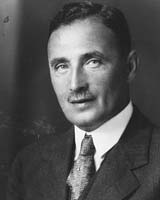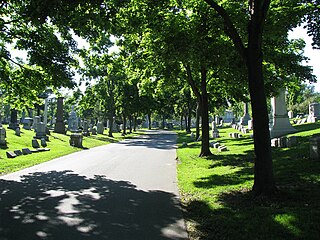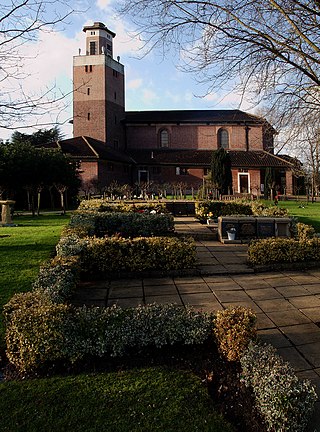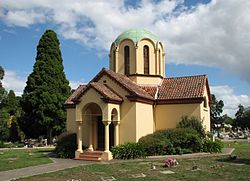
Highgate Cemetery is a place of burial in north London, England. There are approximately 170,000 people buried in around 53,000 graves across the West and East Cemeteries. Highgate Cemetery is notable both for some of the people buried there as well as for its de facto status as a nature reserve. The Cemetery is designated Grade I on the Register of Historic Parks and Gardens. It is one of the Magnificent Seven cemeteries in London.

Kensal Green Cemetery is a cemetery in the Kensal Green area of Queens Park in the Royal Borough of Kensington and Chelsea in London, England. Inspired by Père Lachaise Cemetery in Paris, it was founded by the barrister George Frederick Carden. The cemetery opened in 1833 and comprises 72 acres (29 ha) of grounds, including two conservation areas, adjoining a canal. The cemetery is home to at least 33 species of bird and other wildlife. This distinctive cemetery has memorials ranging from large mausoleums housing the rich and famous to many distinctive smaller graves and includes special areas dedicated to the very young. It has three chapels and serves all faiths. It is one of the Magnificent Seven cemeteries in London.

West Norwood Cemetery is a 40-acre (16 ha) rural cemetery in West Norwood in London, England. It was also known as the South Metropolitan Cemetery. One of the first private landscaped cemeteries in London, it is one of the "Magnificent Seven" cemeteries of London, and is a site of major historical, architectural and ecological interest.
Box Hill North is a suburb of Melbourne, Victoria, Australia, 14 km east from Melbourne's Central Business District, located within the City of Whitehorse local government area. Box Hill North recorded a population of 12,337 at the 2021 census.

Box Hill South is a suburb of Melbourne, Victoria, Australia, 14 km east of Melbourne's Central Business District, located within the City of Whitehorse local government area. Box Hill South recorded a population of 8,491 at the 2021 census.

Burwood East is a suburb of Melbourne, Victoria, Australia, located 17 km east of Melbourne's Central Business District, located within the City of Whitehorse local government area. Burwood East recorded a population of 10,675 at the 2021 census.

Sidney Myer was a Russian-born Jewish-Australian businessman and philanthropist, best known for founding Myer, Australia's largest chain of department stores.

Anfield Cemetery, or the City of Liverpool Cemetery, is located in Anfield, a district of Liverpool, Merseyside, England. It lies to the northeast of Stanley Park, and is bounded by Walton Lane to the west, Priory Road to the south, a railway line to the north, and the gardens of houses on Ince Avenue to the east. The cemetery grounds are included in the National Register of Historic Parks and Gardens at Grade II*.

Forest Hills Cemetery is a historic 275-acre (111.3 ha) rural cemetery, greenspace, arboretum and sculpture garden located in the Forest Hills section of the Jamaica Plain neighborhood of Boston, Massachusetts. The cemetery was established in 1848 as a public municipal cemetery of the town of Roxbury, but was privatized when Roxbury was annexed to Boston in 1868.

Notre Dame des Neiges Cemetery is a 343-acre (139 ha) rural cemetery located in the borough of Côte-des-Neiges-Notre-Dame-de-Grâce, Montreal, Quebec, Canada which was founded in 1854. The entrance and the grounds run along a part of Côte-des-Neiges Road and up the slopes of Mount Royal. Notre Dame des Neiges Cemetery is the largest cemetery in Canada and the third-largest in North America.

Forest Lawn Cemetery is a historic rural cemetery in Buffalo, New York, founded in 1849 by Charles E. Clarke. It covers over 269 acres (1.1 km2) and over 152,000 are buried there, including U.S. President Millard Fillmore, First Lady Abigail Fillmore, singer Rick James, Congresswoman Shirley Chisholm, and inventor Lawrence Dale Bell. Forest Lawn is on the National Register of Historic Places.

Toowong Cemetery is a heritage-listed cemetery on the corner of Frederick Street and Mt Coot-tha Road, Toowong, City of Brisbane, Queensland, Australia. It was established in 1866 and formally opened in 1875. It is Queensland's largest cemetery and is located on forty-four hectares of land at the corner of Frederick Street and Mount Coot-tha Road approximately four and a half kilometres west of Brisbane. It was previously known as Brisbane General Cemetery. It was added to the Queensland Heritage Register on 31 December 2002.

Boroondara General Cemetery, often referred to as Kew cemetery, is one of the oldest cemeteries in Victoria, Australia, created in the tradition of the Victorian garden cemetery. The cemetery, located in Kew, a suburb of Melbourne, is listed as a heritage place on the Victorian Heritage Register.
Dame Jacobena Victoria Alice Angliss, DBE, known as Bena Angliss, was an Australian philanthropist, arts supporter, and community worker.
Sir William Charles Angliss was a butcher, pastoralist, pioneering meat exporter, businessman, and politician in Melbourne, Australia.

The City of London Cemetery and Crematorium is a cemetery and crematorium in the east of London. It is owned and operated by the City of London Corporation. It is designated Grade I on the Historic England National Register of Historic Parks and Gardens.

East Finchley Cemetery is a cemetery and crematorium in East End Road, East Finchley. Although it is in the London Borough of Barnet, it is owned and managed by the City of Westminster.

Maple Grove Cemetery is a historic cemetery at 127-15 Kew Gardens Road in Briarwood/Kew Gardens, Queens, New York City, New York. It was added to the National Register of Historic Places in 2004.

Brigadier General Sir Samuel Augustus Pethebridge, was senior Australian public servant, serving as the Secretary of the Department of Defence in the period 1910–1918. He was acting Secretary for Sir Muirhead Collins (1906–1910). He was also a military administrator, and an army officer.
St Jude's Church, Brighton is an Anglican church on Brighton Road, Brighton, South Australia.























